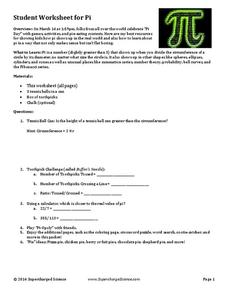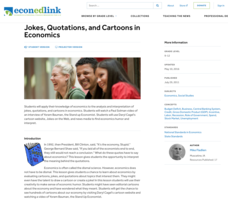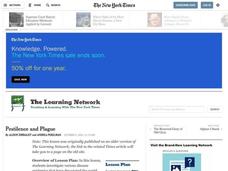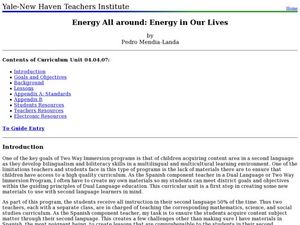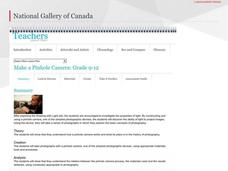Curated OER
Worksheet for Pi
Who needs a pie-eating contest when you have a pi-ology game! Celebrate March 14th with a fun board game about pi and other geometric concepts. As learners answer questions about geometry, they move around the board to collect...
Council for Economic Education
Jokes, Quotations, and Cartoons in Economics
Humor offers a great tool teach the basics of economics to scholars via video clips, satire, and political cartoons. Individuals create their own economic humor to present to the class—with the assistance of Daryl Cagel's online...
National Gallery of Canada
Make a Pinhole Camera
Introduce your class to photography by asking them to construct their own pinhole cameras. After putting together their own devices, pupils take and develop pictures and analyze the results. The plan provides step-by-step instructions...
Curated OER
Zen and the Design of Homework Desks
Young scholars investigate zen. In this design lesson, students use ideas from zen to create a study area. Young scholars understand how different environments affect work habits. Students research how young scholars in other countries...
Curated OER
Applied Maximum Minimum Problems--Mini Golf
Twelfth graders investigate maximum and minimum as it relates to billiard and mini golf. In this calculus lesson plan, 12th graders review how to find the maximum and minimum and write proofs to show how they arrive at their answer. They...
Curated OER
Forensic Colloquium Experience: Debating the Issues
Pupils prepare for an participate in a debate. They watch instructional videos on how debates proceed. Pupils work in teams to research various topics, present their opinions on the issue, and respond to opposing viewpoints during a...
Curated OER
Leonardo da Vinci
Students select appropriate tools and technology to perform tests, collect data, and display data. They construct appropriate graphs from data and develop qualitative statements about the relationships between variables.
Curated OER
Pestilence and Plague
Students investigate various disease epidemics that have devastated the world population at different points in history and examine the diseases' effects on the countries they impacted.
Curated OER
Zoom Out
Students explore visual perception and how objects change as distance changes. In this distance and vision instructional activity, students practice their scientific inquiry skills. Students practice drawing objects from different points...
Curated OER
Using Java Applets for Inquiry-Based Physics Lessons
Using Java Applets in the physics classroom can be a great way to reinforce scientific concepts.
Curated OER
Geographic Luck
Students examine why some countries are rich while others remain poor. They view a video on the website, Guns, Germs and Steel, analyze primary sources to conduct research about plants and animals, and create a game based on their research.
Curated OER
Four Color Map
Students explore geometry by completing a color puzzle. In this shape identification lesson, students utilize deductive reasoning to complete a Google SketchUp puzzle with trapezoid, triangles and rectangular shapes. Students...
Curated OER
Energy All Around: Energy in Our Lives
Young scholars identify the different sources of energy. In this energy lesson, students list different machines and identify the type of energy used to operate them. They create a diagram of a wind turbine and label its parts.
Curated OER
Exploring the Celestial Neighborhood
Ninth graders study the origin and organization of the solar system. They investigate the Earth's place in the system and how planetary motions explain natural phenomena observable from Earth.
Curated OER
Hare and Lynx Population
Fourth graders study changes in animal population. For this graphing lesson, 4th graders create graphs from information read to them about hares and lynx populations. They will describe patterns of change in the graphs and discuss why...
Curated OER
NOVA Online/Einstein Revealed
Welcome to the companion Web site to the NOVA program "Einstein Revealed," originally broadcast in October, 1996. This two-hour special presents a penetrating profile of Albert Einstein, who contributed more than any other scientist to...
Curated OER
Fibonacci I
Fifth graders have the opportunity to gather information themselves on Fibonacci and on the occurrence of Fibonacci numbers in nature. They divide up into groups of 2 to 4 to research.
Curated OER
Textbook Questions: Introduction to Economics
In this introduction to economics worksheet, students read the noted textbook pages and then respond to 4 short answer questions about the material they read.
Curated OER
Electric Circuits
Students explore energy by completing an electricity worksheet. In this conductors lesson plan, students define the energy related vocabulary terms circuit, electronics, conductor and semi-conductor before examining computer chips in...
Curated OER
Assassination and Aftermath: The Death of JFK and the Warren Report
Students examine the ways in which the assassination of President John F. Kennedy affected American history and American culture. They explain the role of the media in documenting American history and also influencing that history.
Curated OER
Inventing and Presenting Unit 2: Effective Speeches and Building the Invention
Pupils identify the characteristics of effective speeches. Students find elements of good speeches in the text and in the delivery of model speeches. Pupils build a working three-dimensional model of an invention or an actual invention...
Curated OER
Make a Pinhole Camera
High schoolers explore the ability of light to project images by making and using a pinhole camera.
Curated OER
Comparing Notes: a Mathematical Exploration of the Piano
Young scholars examine the history of equal temperament, the modern standard of tuning a piano. Proportion calculations of octaves and perfect fifths are utilized to calculate the frequency of each note in a major scale.
Curated OER
Atomic Time Lines
Students understand the evolution of the atomic model from Ancient Greece to the present. They then choose one of the options as a project using class time to do research and to be creative.
